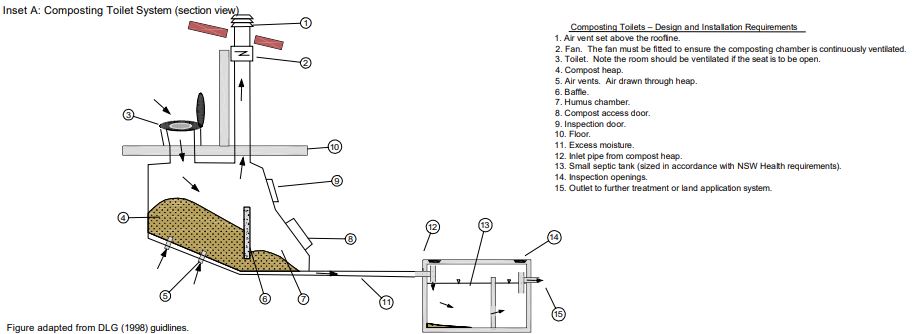Composting Toilet Systems
Composting toilet systems are aerobic processes that treat human waste,
without water, using decomposition. In recent years several commercial
composting toilets have begun to replace conventional septic/sewer
systems in private and public facilities.
These systems reduce the volume of 'humanure' and other organic materials on site over months or years and yield a fertilizer that is able to be utilized in horticultural or agricultural applications. They are also becoming more common as an accepted alternative in homes, where the odor-free operation of a properly functioning unit appeals more to some houseowners than conventional toilets, with their consumption of large quantities of clean water.
The primary objective of the system is to contain, immobilize, or destroy pathogens, thereby reducing the risk of human infection to acceptable levels without contaminating the environment or negatively affecting the life of its inhabitants. They can be used almost anywhere a flush toilet can be used. They are typically used for seasonal homes, homes in remote areas that cannot use flush toilets, or recreation areas, etc.

Composting toilet systems: advantages
- Do not require water for flushing, and thus, reduce domestic water consumption.
- These systems reduce the quantity and strength of wastewater to be disposed of onsite.
- They are especially suited for new construction at remote sites where conventional onsite systems are not feasible.
- Have low power consumption.
- Self-contained systems eliminate the need for transportation of wastes for treatment/disposal.
- Composting human waste and burying it around tree roots and non-edible plants keeps organic wastes productively cycling in the environment.
- Can accept kitchen wastes, thus reducing household garbage.
- In many states, installing a composting toilet system allows the property owner to install a reduced-size leachfield, minimizing costs and disruption of landscapes.
- Composting toilet systems divert nutrient and pathogen containing effluent from soil,surface water, and groundwater.
- No need to dig pits.
- Does not pollute the ground or surface water or the soil.
- Does not produce flies, mosquitoes or smell.
- Totally self-contained sewage treatment on site.
- Produces safe, useful, non-odorous compost.
- The evaporative plant bed can support growth of attractive flowers, fuel wood, vegetable or plantain.
- Composting toilet systems divert nutrient and pathogen containing effluent from soil,surface water, and groundwater.
- No need to dig pits.
- Does not pollute the ground or surface water or the soil.
- Does not produce flies, mosquitoes or smell.
- Totally self-contained sewage treatment on site.
- Produces safe, useful, non-odorous compost.
- The evaporative plant bed can support growth of attractive flowers, fuel wood, vegetable or plants.

Disadvantages
- Maintenance of systems requires more responsibility and commitment by users and owners than conventional wastewater systems.
- Removing the finished end-product is an unpleasant job if the composting toilet system is not properly installed or maintained.
- Must be used in conjunction with a greywater system in most circumstances.
- Smaller units may have limited capacity for accepting peak loads.
- Improper maintenance makes cleaning difficult and may lead to health hazards and odor problems.
- Using an inadequately treated end-product as a soil amendment may have possible health consequences.
- There may be aesthetic issues because the excrement in some systems may be in sight.
- Too much liquid residual (leachate) in the composter can disrupt the process if it is not drained and properly managed.
- Most systems require a power source.
- Improperly installed or maintained composting toilet systems can produce odors and unprocessed material.
Composting toilet plans like those shown above are available from any vendor of these systems and will outline the simple setup, mostly via a kit system.
Note: New systems are now available that can be placed on a slab and have horizontal collectors.
You can also look at how to install a regular toilet here.
Return to Bathrooms home page
or return to kithomebasics home page




